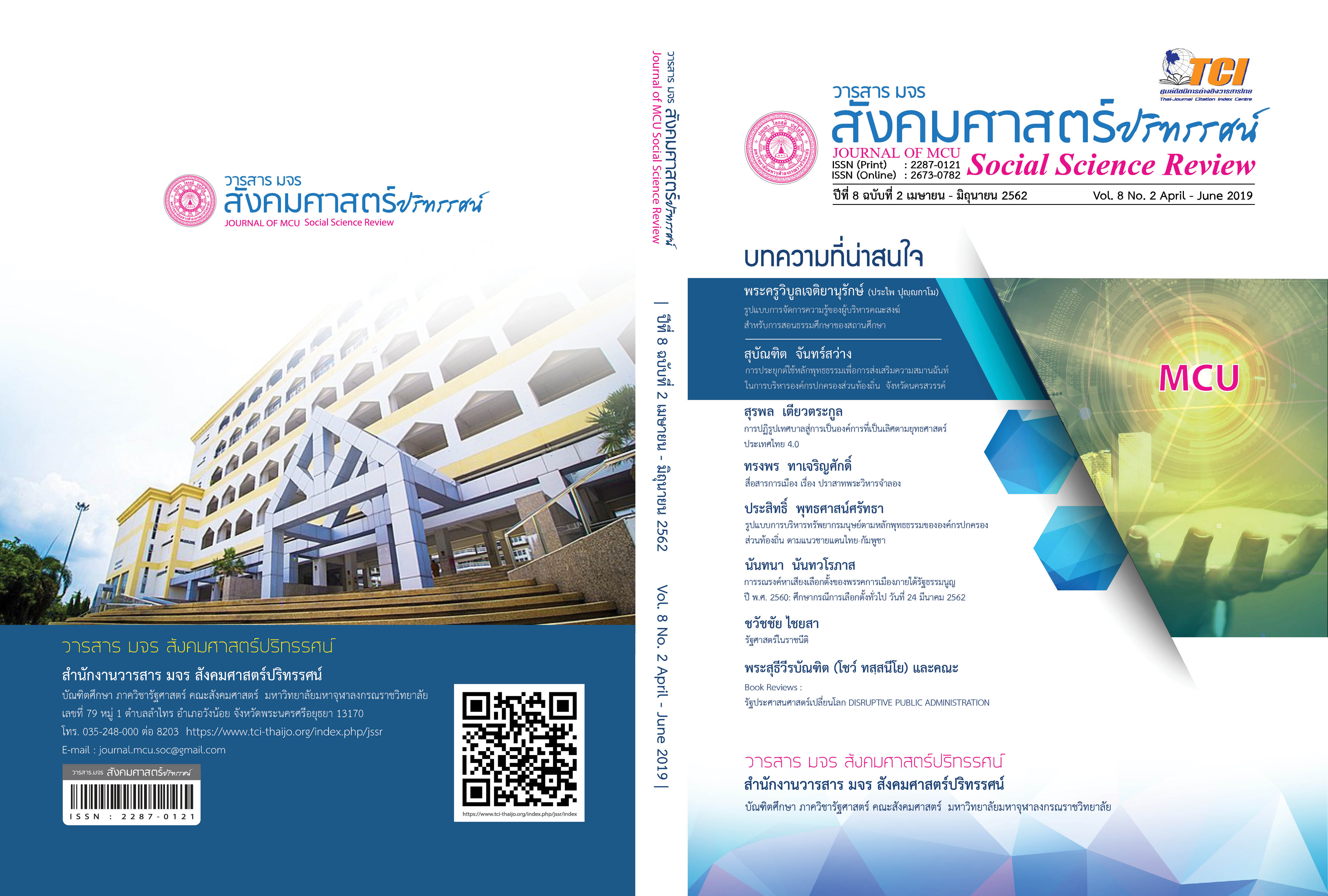บทบาทของกรมส่งเสริมอุตสาหกรรมในการขับเคลื่อนยุทธศาสตร์ 4.0 ตามนโยบายของรัฐบาล
คำสำคัญ:
บทบาทของกรมส่งเสริมอุตสาหกรรม, ยุทธศาสตร์การขับเคลื่อน ,นโยบายของรัฐบาลบทคัดย่อ
บทความวิจัยนี้มีวัตถุประสงค์ 1) เพื่อศึกษาการปฏิบัติการเชิงรุกของกรมส่งเสริมอุตสาหกรรมในการขับเคลื่อนอุตสาหกรรมเชิงรุก ให้สอดรับกับนโยบายประเทศไทย 4.0
2) เพื่อศึกษาองค์ประกอบที่ส่งเสริมในการขับเคลื่อนอุตสาหกรรมเชิงรุก ให้สอดรับกับนโยบายประเทศไทย 4.0 และ 3)เพื่อศึกษาแนวทางในการพัฒนาบทบาทของกรมส่งเสริมอุตสาหกรรมในการขับเคลื่อนยุทธศาสตร์ประเทศไทย
การวิจัยครั้งนี้เป็นการวิจัยเชิงคุณภาพ (Qualitative Research) เป็นวิธีการเพื่ออธิบายปรากฏการณ์ของการเปลี่ยนแปลงองค์การด้านกรมส่งเสริมอุตสาหกรรม โดยใช้วิธีการหลากหลายเพื่อเก็บข้อมูลสำหรับผลการวิจัยในครั้งนี้ มีข้อค้นพบโดยสรุป กล่าวคือ
ประการแรกด้านข้อกฎหมายของกรมส่งเสริมอุตสาหกรรม คือ ต้องมีการปรับแก้ข้อกฎหมายและกฎระเบียบที่เอื้อต่อการพัฒนากรมส่งเสริมอุตสาหกรรม เพราะหากยังไม่มีการปรับแก้ในลักษณะดังกล่าว การเปลี่ยนผ่านไปสู่รัฐบาลดิจิทัลจะเป็นไปได้ยาก นอกจากนี้ การปรับแก้กฎหมายและกฎระเบียบเพื่อให้สามารถดำเนินต่อไปได้ด้วยดีนั้น ไม่ใช่เพียงแต่ต้องแก้กฎหมายและกฎระเบียบเท่านั้นแต่ยังคาบเกี่ยวไปถึงกฎหมายและกฎระเบียบด้านอื่นๆ ที่เกี่ยวข้องซึ่งต้องมีการทบทวนไปพร้อม ๆ กัน
ประการที่สองด้านการพัฒนาความสามารถในการแข่งขัน คือ จะต้องปรับปรุงรูปแบบและวิธีการทำงานของภาครัฐ ให้เกิดการบูรณาการการทำงานในลักษณะข้ามกระทรวง โดยเฉพาะอย่างยิ่งหน่วยงานภาครัฐต่าง ๆ ต้องบูรณาการการทำงานร่วมกันในลักษณะที่เป็นองค์รวมแทนที่การทำงานแบบแยกส่วนดังที่เคยปฏิบัติในช่วงที่ผ่านมาเพื่อให้กลไกต่าง ๆ สามารถทำงานได้อย่างสมดุลและมีประสิทธิภาพ โดยมีการกำหนดเจ้าภาพรับผิดชอบในแต่ละภารกิจเมื่อมีการทำงานร่วมกันหรือเชื่อมโยงกันอย่างเป็นระบบ
ประการที่สามด้านการพัฒนานวัตกรรมเทคโนโลยี คือ ต้องมีการทําสิ่งต่างๆ ด้วยวิธีใหม่ๆการสร้างสรรค์การพัฒนาต่อยอดการเปลี่ยนแปลงทางความคิดการจัดการการผลิตกระบวนการระบบโครงสร้างองค์กรรูปแบบธุรกิจเพื่อที่จะสร้างมูลค่าใหม่ๆ สําหรับลูกค้าและผลตอบแทนทางการเงินให้กับธุรกิจโดยเป็นที่ยอมรับต่อสังคมและสิ่งแวดล้อม ไม่ขัดต่อหลักศีลธรรม จรรยาบรรณ ขนบธรรมเนียม ประเพณีต่างๆ ทั้งนี้มักมีการแยกแยะความแตกต่างอย่างชัดเจนระหว่างการประดิษฐ์คิดค้นความคิดริเริ่มและนวัตกรรม
ประการที่สี่ด้านการพัฒนาคนแนวใหม่ คือ ต้องมีการพัฒนาคนแบบ Inside Out Approach ซึ่งเป็นกลยุทธ์ในการพัฒนาคนโดยมุ่งเน้นการพัฒนาจากภายใน (ทัศนคติ แรงจูงใจ อุปนิสัย) สู่การพัฒนาภายนอก (ความรู้ ทักษะ พฤติกรรม) การพัฒนาสิ่งที่อยู่ภายในใจของคนได้ การพัฒนาความรู้ทักษะ และพฤติกรรมของคนก็สามารถทำได้ง่ายขึ้นอย่างแน่นอน
เอกสารอ้างอิง
Chandarasorn, V.(2008). Theory of Public Policy to Practice. Bangkok: Prikwhan Graphic. (in Thai)
Christoph Knill & Jale Tosun. (2012). Public Policy. Palgrave Macmillan. New York, NY.
Donald F. Kettl & James W. Fesler. (2005). The Politics of The Administrative Process. CQ Press. Washington, D.C.
Dudley D. Cahn, Ruth Anna. (2007) Abigail Managing Conflict Through Communication.
Drucker, Peter F. (2004). The Practice of Management. New York : Harper& Row, Publishers.
Education, Department of, Ministry of Education (2011).(online). E-learning; Strategic Learning in The Future. MongKai Journal , 2(7), 48. http://www.moe.go.th/
moe/th/home/ 21 January 2017.
Feigl, M.D. , Hill, J.W. and Boschmann,.E. (2001) Foundations of Life, Macmilian
Publishing Company, U.S.A.
French, Wendell L. (2010). Human Resources Management. (3rd ed.) Boston, MA : HoughtonMifflin.
Gurr, Gary Alan. (2012, June). Restructuring a Traditional Junior High Schoolinto ACommunityBased Intergenerational Learning Center: A Case Study of Public Agency Partnerships, Dissertation Abstracts International. 55 (12): 3961.
Henri Fayol. (2004). General and Industrial Administration. New York : Pitman.
Michael E. Porter. (2005). Competitive Andvantage. A Division of Simon & Schuster Inc. New York, NY.
Maharatsakul, P.(2006). How to Strategic Management For Globalization Coping. Quality, 12 (1998).
Philip Kotler. (2017). Marketing 4.0. John Wiley & Sons, Inc., Hoboken, New Jersey.
Plan, Development of Digital and Social. (2016). Development of Digital and Social Plan (on line). www. mict.go.th/ assets/ portals/ 1/files/ 590613_4Digital_Economy_Plan-Book.pdf , 21 January 2017.
Pinaisub, B.(2012). Trend of Organization Management and Personal Role Changing in Organization of Thailand in 2027. Public Administration Faculty, NIDA.
Public Sector Development Commission, Office of. Thai Bureaucracy System in Developing Strategic Plan (2013-2018), Vision Print and Media Printed.(2013).
Rakkhwamsuk, E.,(2016). Qualitative Research, Principle and Practice. Bangkok, DuanTula Printed .(in Thai)
Rakkhwamsuk, E.,(2017). New Public Service by Provincial Parliamentary Office, Humanities and Social Sciences Western University Vol.3 No.1 (January - April 2017).
Sompong, S.,(2015). The Following of Evaluation , Efficiency and Competency of Local Administration, Office of the Decentralization Commission Prime Minister's Office.
Sakvoravit,A., (2008). Competency Concept., The Old Story We are Confused: Chulalongkorn University.
ดาวน์โหลด
เผยแพร่แล้ว
รูปแบบการอ้างอิง
ฉบับ
ประเภทบทความ
สัญญาอนุญาต
ลิขสิทธิ์ (c) 2019 วารสาร มจร สังคมศาสตร์ปริทรรศน์

อนุญาตภายใต้เงื่อนไข Creative Commons Attribution-NonCommercial-NoDerivatives 4.0 International License.
เพื่อให้เป็นไปตามกฎหมายลิขสิทธิ์ ผู้นิพนธ์ทุกท่านต้องลงลายมือชื่อในแบบฟอร์มใบมอบลิขสิทธิ์บทความให้แก่วารสารฯ พร้อมกับบทความต้นฉบับที่ได้แก้ไขครั้งสุดท้าย นอกจากนี้ ผู้นิพนธ์ทุกท่านต้องยืนยันว่าบทความต้นฉบับที่ส่งมาตีพิมพ์นั้น ได้ส่งมาตีพิมพ์เฉพาะในวารสาร มจร สังคมศาสตร์ปริทรรศน์ เพียงแห่งเดียวเท่านั้น หากมีการใช้ภาพหรือตารางหรือเนื้อหาอื่นๆ ของผู้นิพนธ์อื่นที่ปรากฏในสิ่งตีพิมพ์อื่นมาแล้ว ผู้นิพนธ์ต้องขออนุญาตเจ้าของลิขสิทธิ์ก่อน พร้อมทั้งแสดงหนังสือที่ได้รับการยินยอมต่อบรรณาธิการ ก่อนที่บทความจะได้รับการตีพิมพ์ หากไม่เป็นไปตามข้อกำหนดเบื้องต้น ทางวารสารจะถอดบทความของท่านออกโดยไม่มีข้อยกเว้นใดๆ ทั้งสิ้น





